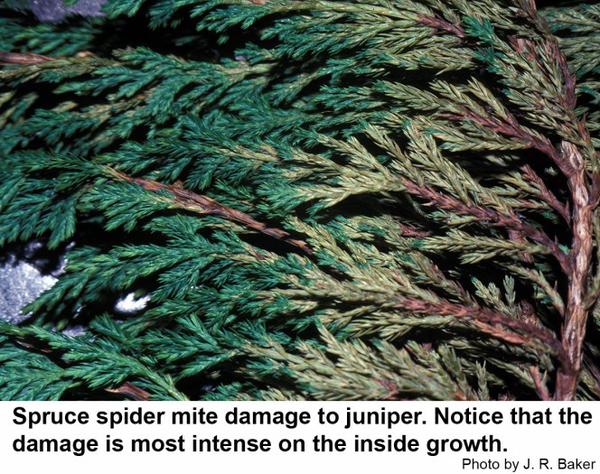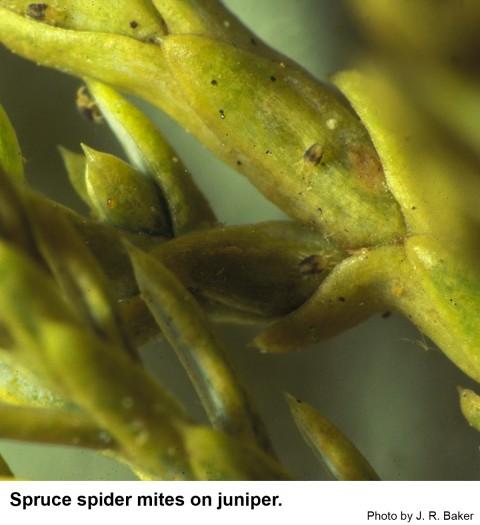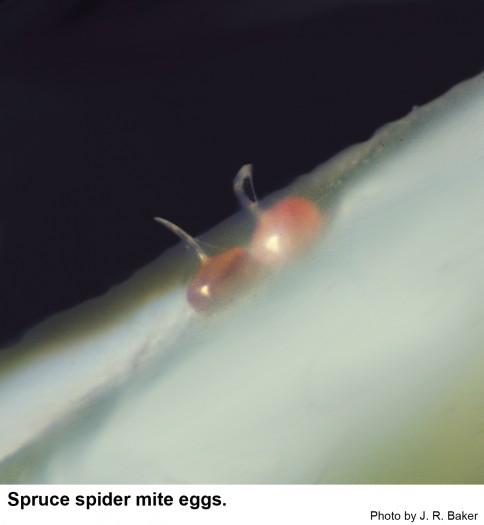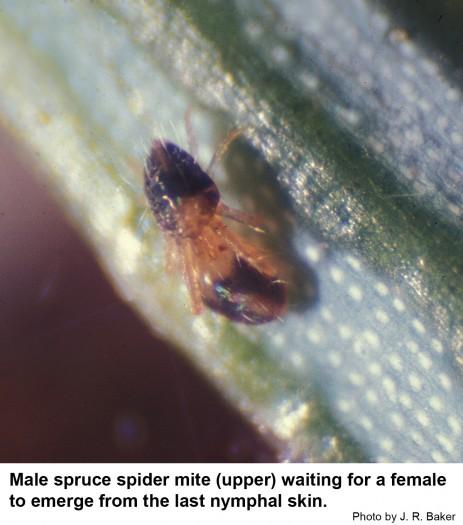Description and Biology
The most common spider mite pest of conifers in North Carolina is the spruce spider mite, Oligonychus ununguis. The spruce spider mite is one of the "cool weather" mites. Spruce spider mite eggs are spherical, but slightly flattened and have a diagnostic stipe (thread) projecting up from the center. The first stage (the larva) is only slightly larger than the egg. Larvae have six legs. Later immature stages are called nymphs. Like adults, nymphs have eight legs. Spruce spider mites are relatively inactive in cold weather and tend to die out in hot weather. Only the eggs survive hot summers and very cold winters. At upper elevations, the spruce spider mite may be active all summer long. Males mate with females as soon as the females molt into the adult stage and females soon begin laying eggs. Most reproduction takes place in spring and fall. Spruce spider mites also overwinter as eggs usually laid at the base of needles. In April and May the eggs hatch and larval mites begin feeding and developing. Most feeding damage takes place in spring and fall. These mites usually do not cause dieback, which is usually caused by scale insects or some other problem.
Host Plants
Spruce spider mites feed on spruce, arborvitae, Douglas fir, Fraser fir, hemlock, juniper, pine, and other conifers in nurseries and landscapes. Spruce spider mites feed by poking their sharp, scissor-like mouthparts into a needle, injecting saliva, and then sucking out the predigested "soup." They do most of their damage in spring and fall. However, the foliage may not turn yellowish-brown until June or July after the mites have already died out for the summer (only the eggs survive the summer in the Piedmont and Coastal Plain).
Residential Recommendation
Because the spruce spider mite tends to feed on older growth, thorough coverage is necessary to get the pesticide inside the plant where the mites are feeding. This mite is not particularly resistant to miticides. Consider using one of the horticultural oils because oils are not only effective for spider mites, they also control other pests of conifers such as aphids, juniper scale, and minute cypress scale.
References
- Insect and Related Pests of Shrubs. Baker, J. R. ed. 1980. NC Agricultural Extension Service publication AG-189. 199 pp.
- Southern Red Mite and Spruce Spider Mite. Frank, S. D. et al. 2011. Entomology Insect Notes, NC State Extension Publications.
- Spruce Spider Mite on Fraser Fir. Sidebottom, J. 2009. Christmas Tree Notes, NC State Extension Publications.
- Extension Plant Pathology Publications and Factsheets
- Horticultural Science Publications
- North Carolina Agricultural Chemicals Manual
For assistance with a specific problem, contact your local N.C. Cooperative Extension Center.
This Factsheet has not been peer reviewed.
Publication date: April 19, 2013
Revised: Oct. 15, 2019
Recommendations for the use of agricultural chemicals are included in this publication as a convenience to the reader. The use of brand names and any mention or listing of commercial products or services in this publication does not imply endorsement by NC State University or N.C. A&T State University nor discrimination against similar products or services not mentioned. Individuals who use agricultural chemicals are responsible for ensuring that the intended use complies with current regulations and conforms to the product label. Be sure to obtain current information about usage regulations and examine a current product label before applying any chemical. For assistance, contact your local N.C. Cooperative Extension county center.
N.C. Cooperative Extension prohibits discrimination and harassment regardless of age, color, disability, family and marital status, gender identity, national origin, political beliefs, race, religion, sex (including pregnancy), sexual orientation and veteran status.




